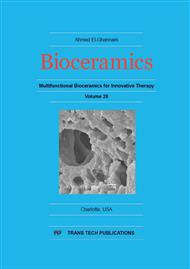[1]
Baelum V, van Palenstein Helderman W, Hugoson A, Yee R, Fejerskov O. A global perspective on changes in the burden of caries and periodontitis: implications for dentistry. J Oral Rehabil 2007; 34: 872.
DOI: 10.1111/j.1365-2842.2007.01799.x
Google Scholar
[2]
Cordeiro MM, Z Dong Z, Kaneko T, Zhang Z, Miyazawa M, Shi S, et al. Dental pulp tissue engineering with stem cells from exfoliated deciduous teeth. Journal of Endodontics 2008; 34: 962–9.
DOI: 10.1016/j.joen.2008.04.009
Google Scholar
[3]
Ruch JV, Lesot H, Begue CK. Odontoblast differentiation. International Journal of Developmental Biology1995; 39: 51–68.
Google Scholar
[4]
Couble ML, Farges JC, Bleicher F, Perrat-Mabillon B, Boudeulle M, Magloire H. Odontoblast differentiation of human dental pulp cells in explants cultures. Calcified Tissue International 2000; 66: 129–38.
DOI: 10.1007/pl00005833
Google Scholar
[5]
National Institute of Dental and Craniofacial Research. Biomimetics and tissue engineering. National Institutes of Health, (2002).
Google Scholar
[6]
Young CS, Terada S, Vacanti JP, Honda M, Bartlett JD, Yelick PC. Tissue engineering of complex tooth structures on biodegradable polymer scaffolds. J Dent Res 2002; 81: 695–700.
DOI: 10.1177/154405910208101008
Google Scholar
[7]
Baum BJ, Mooney DJ. The impact of tissue engineering on dentistry. J Am Dent Assoc 2000; 131: 309 –18.
Google Scholar
[8]
Galler, Kerstin M., et al. Self-assembling peptide amphiphile nanofibers as a scaffold for dental stem cells., Tissue Engineering Part A 14. 12 (2008): 2051-(2058).
DOI: 10.1089/ten.tea.2007.0413
Google Scholar
[9]
Qu, Tiejun, and Xiaohua Liu. Nano-structured gelatin/bioactive glass hybrid scaffolds for the enhancement of odontogenic differentiation of human dental pulp stem cells., Journal of Materials Chemistry B 1. 37 (2013): 4764-4772.
DOI: 10.1039/c3tb21002b
Google Scholar
[10]
Yang, Xuechao, et al. The performance of dental pulp stem cells on nanofibrous PCL/gelatin/nHA scaffolds., Journal of biomedical materials research Part A 93. 1 (2010): 247-257.
DOI: 10.1002/jbm.a.32535
Google Scholar
[11]
Zheng, Liqin, et al. The effect of composition of calcium phosphate composite scaffolds on the formation of tooth tissue from human dental pulp stem cells., Biomaterials 32. 29 (2011): 7053-7059.
DOI: 10.1016/j.biomaterials.2011.06.004
Google Scholar
[12]
Kokubo, Tadashi, and Hiroaki Takadama. How useful is SBF in predicting in vivo bone bioactivity?., Biomaterials 27. 15 (2006): 2907-2915.
DOI: 10.1016/j.biomaterials.2006.01.017
Google Scholar
[13]
Wang, Jing, et al. The odontogenic differentiation of human dental pulp stem cells on nanofibrous poly (L-lactic acid) scaffolds in vitro and in vivo., Acta biomaterialia 6. 10 (2010): 3856-3863.
DOI: 10.1016/j.actbio.2010.04.009
Google Scholar
[14]
Bölgen, Nimet, et al. In vitro and in vivo degradation of non-woven materials made of poly (ε-caprolactone) nanofibers prepared by electrospinning under different conditions., Journal of Biomaterials Science, Polymer Edition 16. 12 (2005).
DOI: 10.1163/156856205774576655
Google Scholar


